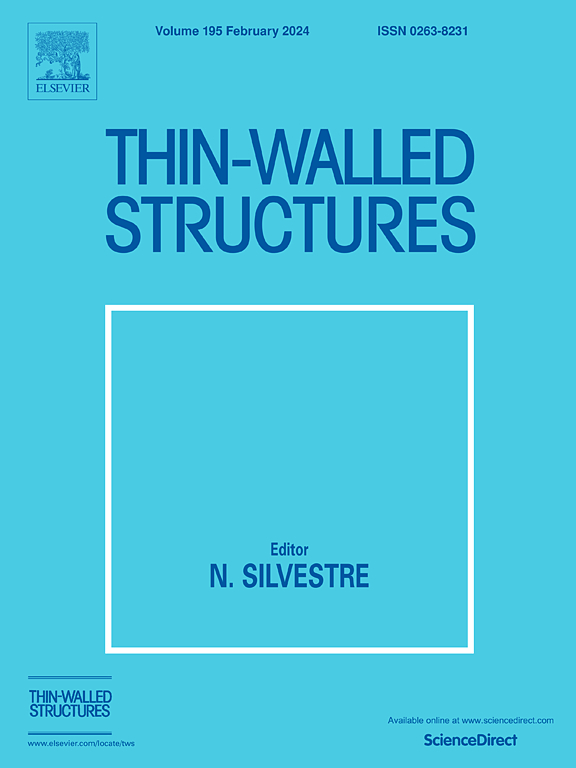High-velocity impact behavior of inert and reactive PELE projectiles against thin-walled targets
IF 6.6
1区 工程技术
Q1 ENGINEERING, CIVIL
引用次数: 0
Abstract
Reactive projectiles offer enhanced lateral effects via impact-induced energy release, yet existing modeling approaches often lack the ability to accurately capture the complex interplay between mechanical fragmentation and chemical reactions. This work addresses this limitation by exploring the fragmentation dynamics, lateral dispersion, and reactivity of Penetrators with Enhanced Lateral Effects (PELE) containing inert (PTFE) and novel reactive fillings (BDO-FP/CuO/Al and Viton/Al), impacting thin-walled metallic plates at an initial velocity around 1000 m/s. Experiments employed a two-stage helium gas gun with high-speed cameras and flash X-ray imaging to visualize projectile–target interactions and perforation characteristics. Numerical simulations were conducted using Smoothed Particle Hydrodynamics (SPH) in LS-DYNA, incorporating Johnson–Cook constitutive laws, stochastic fracture models, and Ignition and Growth Reactive Model equations of state derived from Ab Initio molecular dynamics (AIMD) and computational fluid dynamics (CFD). Experimental results revealed that reactive fillings, particularly Viton/Al, exhibited significantly higher reaction intensity, characterized by intense combustion flashes and broader fragment dispersion with more severe perforation damage compared to inert PTFE. SPH simulations effectively reproduced these phenomena, capturing axial velocity attenuation and radial fragmentation, although minor discrepancies remained in dispersion magnitudes and local perforation geometries. Product species analysis showed that Viton/Al rapidly decomposes into abundant gas-phase species, driving pressure buildup and accelerating combustion. BDO-FP/CuO/Al exhibited delayed, multi-stage decomposition with larger fragments and slower energy release. By integrating experiments with SPH, AIMD, and CFD modeling techniques, this work provides comprehensive insights into PELE behaviors and facilitates the optimization of reactive material formulations for enhanced lateral damage effects.
惰性弹丸和反应弹丸对薄壁目标的高速冲击特性
反应性弹丸通过撞击引起的能量释放提供增强的横向效应,然而现有的建模方法往往缺乏准确捕捉机械破碎和化学反应之间复杂相互作用的能力。这项工作通过探索含有惰性(PTFE)和新型反应性填料(BDO-FP/CuO/Al和Viton/Al)的增强横向效应穿透剂(PELE)的破碎动力学、横向分散和反应性来解决这一限制,以大约1000米/秒的初始速度撞击薄壁金属板。实验采用两级氦气枪,配备高速摄像机和闪光x射线成像,以可视化弹靶相互作用和射孔特性。利用LS-DYNA中的光滑颗粒流体力学(SPH)进行数值模拟,结合Johnson-Cook本构定律、随机裂缝模型以及由Ab Initio分子动力学(AIMD)和计算流体动力学(CFD)导出的点火和生长反应模型状态方程。实验结果表明,与惰性PTFE相比,反应性填料,尤其是Viton/Al的反应强度明显更高,燃烧闪光强烈,碎片分散范围更广,穿孔损伤更严重。SPH模拟有效地再现了这些现象,捕获了轴向速度衰减和径向碎片化,尽管分散幅度和局部射孔几何形状仍然存在微小差异。产物种类分析表明,Viton/Al快速分解为丰富的气相种类,驱动压力积累,加速燃烧。BDO-FP/CuO/Al表现为延迟的多阶段分解,碎片较大,能量释放较慢。通过将实验与SPH、AIMD和CFD建模技术相结合,这项工作提供了对PELE行为的全面了解,并促进了活性材料配方的优化,以增强侧向损伤效应。
本文章由计算机程序翻译,如有差异,请以英文原文为准。
求助全文
约1分钟内获得全文
求助全文
来源期刊

Thin-Walled Structures
工程技术-工程:土木
CiteScore
9.60
自引率
20.30%
发文量
801
审稿时长
66 days
期刊介绍:
Thin-walled structures comprises an important and growing proportion of engineering construction with areas of application becoming increasingly diverse, ranging from aircraft, bridges, ships and oil rigs to storage vessels, industrial buildings and warehouses.
Many factors, including cost and weight economy, new materials and processes and the growth of powerful methods of analysis have contributed to this growth, and led to the need for a journal which concentrates specifically on structures in which problems arise due to the thinness of the walls. This field includes cold– formed sections, plate and shell structures, reinforced plastics structures and aluminium structures, and is of importance in many branches of engineering.
The primary criterion for consideration of papers in Thin–Walled Structures is that they must be concerned with thin–walled structures or the basic problems inherent in thin–walled structures. Provided this criterion is satisfied no restriction is placed on the type of construction, material or field of application. Papers on theory, experiment, design, etc., are published and it is expected that many papers will contain aspects of all three.
 求助内容:
求助内容: 应助结果提醒方式:
应助结果提醒方式:


